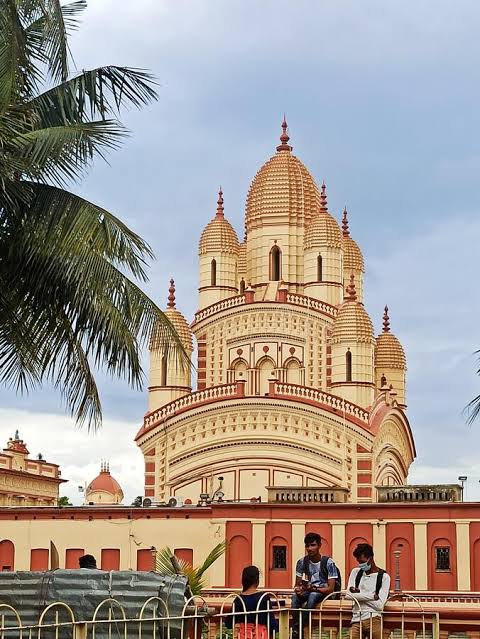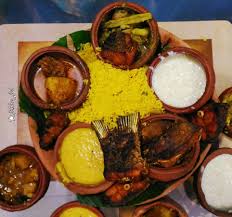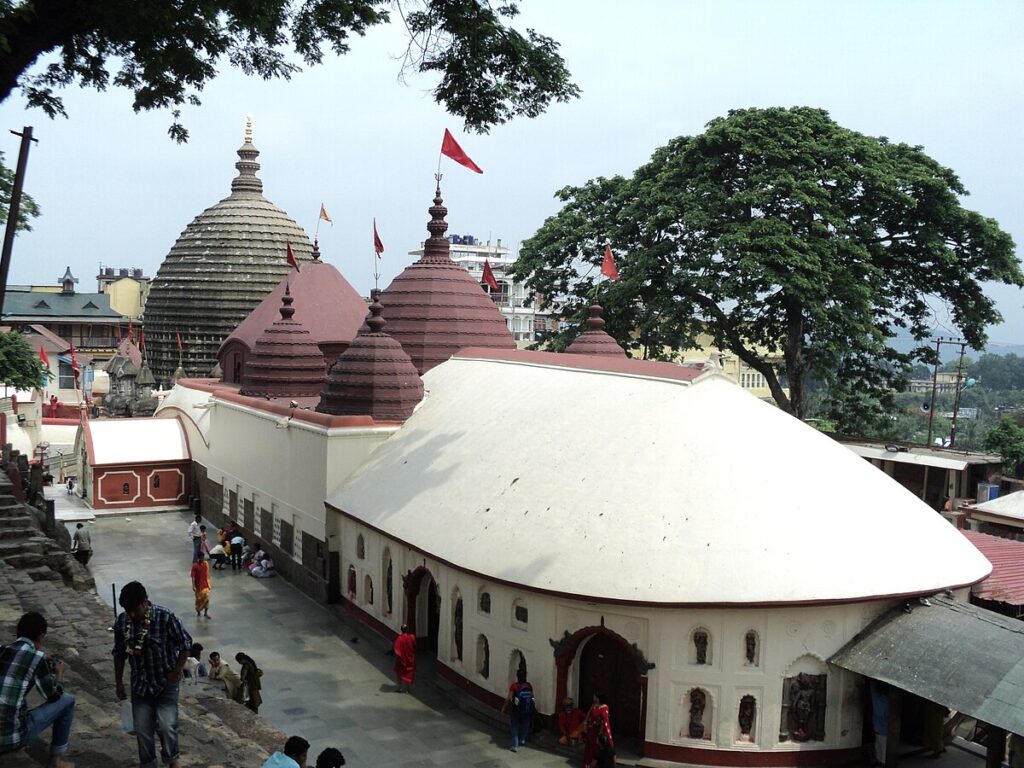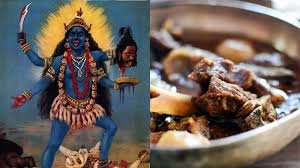In Bengal, the consumption of fish and meat has been deeply ingrained in the region’s culinary and cultural traditions primarily due to its geographical location. Since Kolkata is a city based on the banks of river Ganga, Bengal has always been a riverine province and thus dietary dependence of fish is natural. This dietary preference extends to religious practices, where offerings to deities often include non-vegetarian items, distinguishing Bengali Hindu rituals from mainstream Hindu traditions that predominantly favor vegetarian offerings, in other parts of the country.(bhog)
The meat dish also known as niramish mangsho, (veg meat, as it is cooked without onion and garlic) is the mohabhog or in other words one of the most important sacred offerings to the Goddess
All Hindu temples, primarily offer vegetarian food as “prasad” or “bhog”, whereas one of the renowned temples of Kolkata, Kalighat offers meat and fishes with scales in particular, to Goddess Kali. The meat dish also known as niramish mangsho, (veg meat, as it is cooked without onion and garlic) is the mohabhog or in other words one of the most important sacred offerings to the Goddess.

Mythologically Kalighat is considered one of the shakti-peeths and is dedicated to Goddess Kali, known for fierce and warrior-like form. The common believe runs that since she is the Goddess of strength, she is served non-vegetarian offerings especially meat to ensure protein and to retain her power and strength. Once the goddess is believed to have “accepted” her share, the bhog is distributed among the devotees. This brings up the question that even the food we consider as sacred differs from one part of the country to another, depending on the religious connotations attached to them. Therefore, food is not just based on nutritional needs of an individual but is rather a broader spectrum encompassing the values, norms, motives or the rituals of a culture and religion.(bhog)

The practice of offering meat, particularly in temples dedicated to Shakti (such as those of Kali and Durga), is rooted in Tantric and Sakta traditions, which emphasize the symbolic power of animal sacrifice as a means of devotion. Not only does this temple serve meat as a sacred offering, but the way it is obtained is yet another controversial, but a long-standing ritual of animal sacrifice also known as “boli”.
Also Read: The Sustainability of “Sustainable fashion”
Although animal sacrifice is considered illegal, this practice continues in the Kalighat temple- depicting how strongly the institution of religion has been enforcing its faith, norms and rules in the broader society. This practice underscores the enduring authority of religious institutions in shaping collective conscience. The ritual of “boli” (animal sacrifice) in temples like the Kalighat Temple in Kolkata or the Kamakhya Temple in Assam exemplifies this tradition, where goat meat is considered sacred and later consumed as prasad (blessed food).

Additionally, the cultural and historical significance of meat and fish in Bengali society has influenced religious customs and traditions in Bengali Hinduism. The agrarian lifestyle of the region, with its abundant rivers and fertile lands, made fish and meat easy to access and thus, integral to daily sustenance. Bengal, being a riverine province, has its major dietary dependence on fish, and since Bengalis have always eaten fish or meat regardless of class or caste status, they have never hesitated to offer the same dishes to their deities. As a result, these foods were naturally incorporated into religious offerings as a reflection of both societal norms and devotional practices.(bhog)
In the macro sociological lenses, institutional values and ethics gathered from culture, family, religion or even generations play a significant role in shaping the food that ultimately makes its way to the kitchen or our plates whenever we sit down for a meal
Faith and food come together to create an interesting case study for sociologists. It is made clear that food just like any other social element, has social and cultural values and meanings attached to it and is not independently a decision of an individual or even an institution for that matter. In the macro sociological lenses, institutional values and ethics gathered from culture, family, religion or even generations play a significant role in shaping the food that ultimately makes its way to the kitchen or our plates whenever we sit down for a meal. When meat on one hand is considered a profanity among most Hindu Brahmins in India, here, in Kalighat, it is not only considered sacred enough to be distributed among the devotees, but is also a sacred and one of the most important offerings made to the Goddess of power.(bhog)

It can be said that food has religious aspects that define its value in a particular place at a particular point of time. This duality of the same food item (meat) in different parts of nation says how dynamic a country can be and how a region’s geography, history as well as religious believes are reflected through the dietary practice of the region, making food a cultural indicator of the lives of the people.
Also Read: Social Media- Banes and Boons
Thus, in Bengali Hinduism, food offerings are not solely dictated by pan-Indian Hindu dietary restrictions but are shaped by regional traditions, historical influences, and theological interpretations, making meat a sacred component of bhog in certain temples. Kalighat can be considered an illustrative example of cultural relativism- how religious and food practices are deeply embedded in localized belief systems. Food is more than mere sustenance-operating as a loaded symbolic system, reflecting broader structures of meaning, identity, and culture within society.
All Rights Reserved
Image Courtesy:
Atreyi Biswas is a student of Sociology from Kolkata, India. She has a keen interest in the prevailing social institutions and changing social relationships. Atreyi loves watching movies, documentaries, listening to podcasts, reading articles, short stories and exploring new things.








